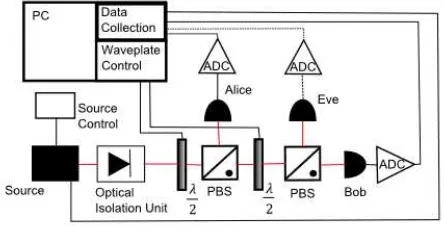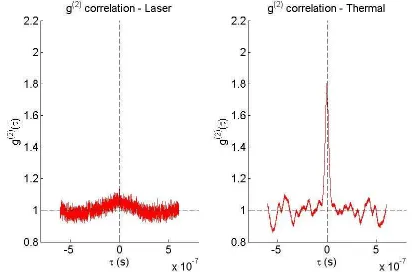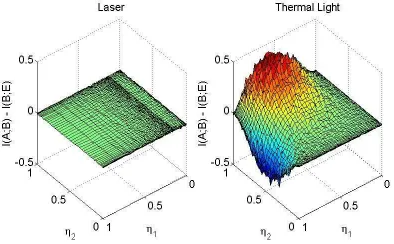Elizabeth Newton, Anne Ghesqui`ere, Freya L. Wilson, and Benjamin T. H. Varcoe Quantum Experimental Group, School of Physics and Astronomy,
University of Leeds, Leeds LS2 9JT, United Kingdom∗ Martin Moseley
Airbus Defense & Space
(Dated: November 20, 2017)
We propose to perform quantum key distribution using quantum correlations occurring within thermal states produced by low power sources such as LED’s. These correlations are exploited through the Hanbury Brown and Twiss effect. We build an optical central broadcast protocol using a superluminescent diode which allows switching between laser and thermal regimes, enabling us to provide experimental key rates in both regimes. We provide a theoretical analysis and show that quantum secrecy is possible, even in high noise situations.
In 2016, China launched what Bingley dubbed the
first quantum satellite [1], the intent of which is to per-form quantum key distribution between the satellite and ground stations, see for instance [2]. This is just one of the current practical schemes designed to perform quan-tum secure key distribution and communication between parties; other examples include the DARPA network [3], the SECOQC project [4], or the Durban-QuantumCity project [5, 6], which use fibre-optic technologies to build quantum networks. These technologies rely on optical communication setups that were proven to be sufficient for performing quantum key distribution (QKD) [7]. Op-tical setups commonly use coherent states, work over great distances and achieve high bit rate; for instance, the Cambridge Quantum Network achieves a secure key rate of about 2.5Mb/s [8, 9]. Such heavy artillery infrastruc-ture is however, conceivably impractical for a plethora of short distance applications which nonetheless require high levels of encryption. Examples include key distri-bution and renewal between a mobile device and a med-ical implant, between an electronic car key and its lock or even between an mobile devide and a password black-box. These low power applications may need shorter key, lower bandwidth and as a result, an infrastructure built on high power lasers, single photons or entangled pho-tons sources, may well be overkill. Reducing light source requirements to LED’s producing thermal states would allow us to explore the realm of low power applications and to appeal to a different set of customers.
The consideration of thermal states as a resource for QKD is not merely a technological preference, quite far from it. Thermal radiation is bunched, meaning that its quanta are likely to be detected in correlated pairs. These correlations produce quantum discord, as demon-strated by Ragy and Adesso using the R´enyi entropy [10]. Furthermore, Pirandola [11] establishes theoretically that non-zero quantum discord is necessary for QKD, and that positive discord in a central broadcast-type protocol al-lows a quantum secure key to be extracted even with high levels of noise. Indeed, quantum discord has been
established as a measure of quantum correlations [12]. Correlations can be qualified using the second-order cor-relation coefficient, generally known as g(2)(τ), defined
as
g(2)(τ) = hY(t)Y(t+τ)i
hY(t)i hY(t+τ)i,
whereY(t) is the radiation intensity. Radiation can then be characterised usingg(2)as : anti-bunched (purely non classical) when g(2)(0) <1, coherent when g(2)(0) = 1,
and bunched when g(2)(0) > 1 [13]. We use this
clas-sification in order to experimentally verify that we are operating in the thermal regime, as can be seen in Fig-ure 2.
To exploit the correlations within bunched pairs re-quires to separate the photons in the pairs and share them between two parties (e.g. Alice and Bob); this is done using the Hanbury Brown and Twiss (HBT) inter-ferometer [14, 15], designed in the 50’s to remedy the shortcomings of amplitude interferometers, such as the Michelson interferometer [16, 17], used in astronomy to determine the radius of stellar objects. The HBT’s table-top set-up is simple : a source is shone onto a beam-splitter, creating two arms, each shining onto a separate detector. The theory behind the observed interference effect has been studied by a number of authors, amongst the first Purcell [18] and Mandel [19, 20], whose papers provide a nicely intuitive pre quantum optical description (see [21]) of the statistics.
Mandel’s analysis relies on the fact that what we count are not the photons themselves, but the photoelectrons ejected by the detector. Fluctuations in that number have two origins : very fast fluctuations in the intensity of the incoming signal, and the stochasticity of the re-action of the photo-sensitive material to its interre-action with the radiation field (namely the ejection of a pho-toelectron). However, the detector is also fundamentally limited by its reaction time (or bandwidth) and therefore, very fast fluctuations may occur undetected. Yet, if these
fluctuations are invisible, the correlations between them are not; in the original experiment and in current radio astronomy, the data used for calculations is often data which has been fed through a correlator (either hardware or software).
The production of photoelectrons is completely char-acterised by its average number nT and several experi-ments have been performed to estimate it, such as [22– 24]. These photon-counting experiments highlight that the bandwidth of the detector relates to the coherence time τc of the source, and that when the observation time T ≪ τc, nT follows a Bose-Einstein distribution. This is in fact, how thermal states are usually modelled in quantum optics, especially since this distribution natu-rally arises through the modelling of blackbody radiation. However, the distribution is also generally used without acknowledgments of its caveats. If the source’s coherence time is suitably long (i.e. the source has a linewidth in the order of kHz), then a detector bandwidth in GHz will allow for the use of the Bose-Einstein distribution, and the resolving of thermal behaviour. However, if the laser linewidth approaches 1Hz, a GHz bandwidth is simply too wide to observe thermal behaviour; all the relevant correlations will be lost. Such a caveat was neglected in articles such as [25] and contributes to erroneous conclu-sions.
A natural objection to the use of thermal states for quantum cryptography is the lifetime of the correlations, perhaps in light of the fragility of entanglement. How-ever, current common implementations include very large telescope arrays such as VLA, ATCA or soon the SKA; another famous usage is the observation of the cosmic microwave background. Furthermore, the original HBT experiment was performed in the optical regine. In ei-ther regime, the correlations survive literally astronomi-cal reaches of free space. The use of thermal states there-fore, naturally emerges as a potential partner to optical QKD techniques, especially with the rise of technologies such as WiFi and Bluetooth, which offer ever-increasing possibilities, such as through wall or medium range free space communications.
Our protocol, shown in Figure 1, is described below.
• Alice creates a beam from a trusted thermal source.
• She then uses a trusted beamsplitter with trans-mittance η1 to divert and detect part of the
trans-mission and send the rest on to Bob (Eve).
• The bunched nature of a thermal source means that fluctuations present at Alice’s detector are corre-lated with those at Bob’s detector.
• These fluctuations can be sliced into bits any num-ber of ways, but with no loss of generality, we as-sume here that a fluctuation above the signal mean is a 1 and one below the mean is a 0.
FIG. 1: (Colour online) Schematic of our central broadcast set-up. The central thermal source sends out
a signal onto a beamsplitterη1, which splits the signal
between Alice and Bob. Alice controls the source and η1. Bob has added noise modelled byη4. Eve performs
a collective Gaussian attack modelled byη2.
• In order to detect an eavesdropper, Alice sends small random chunks of data to Bob who performs ag(2) calculation to verify thermality.
• Alice and Bob now have a stream of independent and randomly correlated bits from which they can derive a key, the security of which they can improve with Cascade and Advantage Distillation, as per any QKD scheme.
Let us emphasise that this is not a prepare-and-send scheme, but instead relies on central broadcasting. This means that though we assume that Alice controls the source, she does not in fact, prepare her states.
Even if Eve intercepts and resends the signal on its way to Bob via the most powerful attack available, we will assume that she has no control over any part of Al-ice’s apparatus, including the source, the beamsplitter (η1) or the detector. Similarly, she has no control over
Bob’s detector. The security of this protocol arises from the correlations within the thermal fluctuations, those re-sponsible for the Hanbury Brown and Twiss effect. Upon arrival atη1 from the source, a bunched pair will either
travel whole to Alice, travel whole onwards to faceη2 or
split between Alice andη2. Any pair travelling onwards
toη2(and thenη4) will suffer the same fate, but the pairs
where χBE is the Holevo bound, between Bob and Eve, wich maximises their mutual informationI(B:E).
The thermal source is modelled using Gaussian statistics, with covariance matrixγin= 2(¯n+ 1)I, where ¯
n is the average photon number andI the identity ma-trix, and null mean. Using such statistics, a beamsplitter is modelled as
where µi =√1−ηi represents the loss. A beamsplitter acts on the state asrout=V rin.
The input state at the first beamsplitter contains the thermal source and a vacuum state; it has covariance matrix and displacement vector
γin=
We want to give Eve the option of inputting a state at η2 so the input state is of the form
block sub-matrix is the input state atη4.
The output covariance matrix is
Γout =
where the block sub-matrices are given in the Appendix. We define our information quantities in terms of the Von Neumann entropy S(ρ) = −Tr (ρlogρ), which for a Gaussian state, is simply determined in terms of the symplectic eigenvaluesxi of its covariance matrix Γ [27], asS(Γ) =Pk
FIG. 2: (Colour online) Experimental results : second order correlation coefficient for (left) coherent states
and (right) thermal states.
is the covariance matrix of B conditionned by a hetero-dyne measurement on A [28].
The protocol was realised experimentally, using a tuneable laser consisting of a superluminescent diode and an external cavity. When run above the operating cur-rent, the laser emitted non-thermal coherent light, and when run below this operating current, it acted as a diode, producing thermal light. This effectively acts as a switch allowing the addition or removal of thermality in the source without altering any other part. We apply no modulation to the signal beyond that of the source. Just as shown on Figure 1, the source diode shines onto a variable beamsplitter.The various signals are detected by photodiodes and the signals then fed to an oscillo-scope. The superluminescent diode has a typical las-ing linewidth of 100kHz, the photodiodes’ bandwidth is 100MHz and the oscilloscope’s 150MHz.
This thermality is shown in Figure 2 where the second order correlations at each regime are shown. We can easily see that
g(2)(0)|thermal> g(2)(0)|coherent,
which we expected. Figure 2(b) shows that in the ther-mal regime,g(2)(0)>1, which means that we are deal-ing with bunched radiation, high fluctuations and as a result, high correlations. Furthermore, we see that since g(2)|coherent ≈ 1, there are no correlations in coherent light because there are no fluctuations, as we expect the-oretically. Now that we have established that we have a thermal source, we shine it through two variable beam-splitters, the first dividing a portion to Alice, and the sec-ond splitting the remaining light between Eve and Bob. We plot the secret key rateK(A:BkE) in Figure 3.
FIG. 3: (Colour online) Experimental results : secret key rate for coherent states (left) versus thermal states (right). η1 is controlled by Alice; whenη1= 1, she has
no signal and therefore, the key rate becomes negative. Similarly, asη1→0, she gains the advantage over Bob
and Eve. As expected, the most advantageous value is whenη1= 0.5.
that K(A:B kE) (which is a lower bound) is negative when η1 → 1, so when no signal goes to Alice and as a
result, she shares no information with Bob. Note that Alice is in control of η1, and we assume that Eve
can-not adversely affect this beamsplitter. When η1 = 0.5,
K(A : B k E) decreases as η2 decreases (so when Eve
gets more of the signal) but nonetheless, it remains posi-tive, meaning that key exchange is always possible, albeit with reduced rate in the high loss regimes. Furthermore, unlike conventional continuous variable schemes, a cen-tral broadcast scheme has the advantage that it does not exhibit a sharp drop off, so a secret key can always be produced.
Figure 4a shows the secret key rate and the discord for a passive and for an active Eve. We have used the Bose Einstein distribution
¯
n= 1 e~ω/
kB T−1, (1)
acknowledging all the caveats highlighted in the intro-duction, and considered narrowband detectors measuring radiation at 30GHz and T = 300K, so that ¯n = 1309. We have kept a vacuum state coming into the second arm at η4 but chosen very low transmittance at η4 so
that Bob will receive a very small portion of the signal. Even in such a high loss situation, the secret key rate is positive, and we can conclude that there is secrecy. Furthermore, the discord is positive, so the correlations are quantum correlations in thermal states, shared over a central broadcast scheme. This means that the key produced is quantum secure.
It is easy to see that if Eve’s input[29] is not a vac-uum state, the key rate and discord begin at a much reduced value. Looking at the Holevo boundsχAE and χBE shown on Figure 4b, we can see how her input of a thermal state affects her. On the whole, the maximum
in-(a)
(b)
FIG. 4: (Colour online) (a) Secret key rate and Discord vsη2 and (b)χAE andχBE, for Eve passive
(g=h= 1) and active (g=h= 150),η1 at -3dB,η4 at
-10dB,a=b= 1309,r=s= 1. The x-axis of (a) begins at η2= 0.1 for readability.
formation available to her is very much decreased, which shows that she suffers from the extra noise just as Alice and Bob do. It is interesting to see though, that much as we would expect, her presence in the transmission does severe harm to the correlations. This protocol seems as a result, much more sensitive to Eve’s presence than Alice and Bob might like it to be, even if Eve does not partic-ularly come out of it better off. In fact, it is possibly a benefit for her to remain in a non-ideal situation and in-put a thermal state, whereby upon reverse reconciliation, she may gain enough information to make some kind of key, relatively unbeknownst to Alice or Bob.
rate is sufficient. For instance, a daily AES key update would only require a 10mHz key rate. Furthermore, we have already mentioned that the HBT effect survives as-tronomical distances, which renders the issue of distance in our case, essentially moot.
A central broadcast scheme is attractive because the source need not be controlled to the extent of a point-to-point scheme, and two parties can negotiate a key based on their correlated local noise. This leads to a number of potential applications for key exchange in a microwave system, such as long distance satellite communications and for example, between mobile phones in a mobile net-work, mass synchronisation of secure keys within an office space connected to a WiFi node, or even key synchroni-sation between a mobile phone and an implanted medical device.
The authors are grateful to network collaborators J. Rarity, S. Pirandola, C. Ottaviani, T. Spiller, N. Lukten-haus and W. Munro for very fruitful discussions. This work was supported by funding through the EPSRC Quantum Communications Hub EP/M013472/1 and ad-ditional funding for F.W. from Airbus Defense & Space.
[1] Elizabeth Gibney. One giant step for quantum internet.
Nature, 535:478–479, 2016.
[2] Sheng-Kai Liao et al. Nature, 549(7670):43–47, 2017. [3] Chip Elliott, Alexander Colvin, David Pearson,
Olek-siy Pikalo, John Schlafer, and Henry Yeh. arxiv:quant-ph/0503058v2, 2005.
[4] M Peev et al. New Journal of Physics, 11(7):075001, 2009.
[5] Francesco Petruccione and Abdul Mirza.Quest, 6(2):52– 55, 2010.
[6] Abdul Mirza and Francesco Petruccione. J. Opt. Soc. Am. B, 27(6):A185–A188, 2010.
[7] Nicolas Gisin, Gr´egoire Ribordy, Wolfgang Tittel, and Hugo Zbinden. Rev. Mod. Phys., 74:145–195, 2002. [8] Adrian Wonfor et al. High performance field trials of qkd
over a metropolitan network.Poster presentation QCrypt 2017, 2017.
[9] Andrew Shields. Practical demonstration QCrypt 2017, 2017.
[10] Sammy Ragy and Gerardo Adesso. Physica Scripta, 2013(T153):014052, 2013.
[11] Stefano Pirandola. Scientific Reports, 4:6956, 2014. [12] Kavan Modi, Aharon Brodutch, Hugo Cable, Tomasz
Pa-terek, and Vladko Vedral. Review of Modern Physics, 84(4):1655(53), 2012.
[13] Mark Fox. Quantum Optics An Introduction. Oxford University Press, 2006.
[14] R. Hanbury Brown and R. Q. Twiss. Nature, 177:27–29, 1956.
[15] R. Hanbury Brown and R. Q. Twiss. Nature, 178:1046– 1048, 1956.
[16] Albert A. Michelson. American Journal of Science, 22:120–129, 1881.
[17] Albert A. Michelson and Edward W. Morley. American Journal of Science, XXXIV(203):333–345, 1881. [18] E. M. Purcell.Nature, 178:1449–1450, 1956.
[19] L Mandel. Proceedings of the Physical Society, 72(6):1037, 1958.
[20] L Mandel.Proceedings of the Physical Society, 74(3):233, 1959.
[21] Roy J. Glauber. Phys. Rev., 131:2766–2788, 1963. [22] P.K. Tan, G.H. Yeo, H.S. Poh, A. H. Chan, and C.
Kurt-siefer. The Astrophysical Journal Letters, 789, 2014. [23] M.L. Mart´ınez Ricci, J. Mazzaferri, A. V. Bragas, and
E. O. Mart´ınez. Am. J. Phys., 75(8):707–712, 2007. [24] P. Koczyk, P. Wiewi´or, and C. Radzewicz.Am. J. Phys.,
64(3):240–245, 1995.
[25] Christian Weedbrook, Stefano Pirandola, and Timo-thy C. Ralph.Physical Review A, 86(2):022318(12), 2012. [26] U. M. Maurer.IEEE Transactions on Information
The-ory, 39(3):733–742, 1993.
[27] Ra´ul Garc´ıa-Patr´on Sanchez. PhD Thesis Universit´e Li-bre de Bruxelles, 2007.
[28] Christian Weedbrook, Stefano Pirandola, Ra´ul Garc´ıa-Patr´on, Nicolas J. Cerf, Timothy C. Ralph, Jeffrey H. Shapiro, and Seth Lloyd. Review of Modern Physics, 84(2):621(49), 2012.
[29] We assume without loss of generality, that the beamsplit-ter induces no phase-shift.
Full results
On the output ofη2, the submatrices are as follows
γa=
On the output ofη4, the submatrices are as follows
Γbv=
µ4√η4 Xv2
−
X2
b
0 0 µ4√η4 Pv2
−
P2
b


